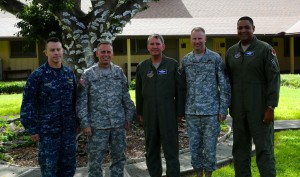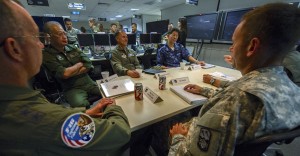2014-03-06 By Robbin Laird
During a visit to PACOM in late February 2014, I had the chance to interview the Commanding General of the 94th Army Air and Missile Defense Command located at Fort Shafter near Honolulu, Brig. Gen. Daniel Karbler.
Notably, if you look at his background you see that he learned his trade under fire in the Middle East, having deployed to Israel in 1991 as part of Task Force Patriot Defender in support of Desert Storm and deployed to Riyadh, Saudi Arabia in support of Operations Desert Thunder II and Desert Fox.
Talking with the General and his team was not simply a Washington-based seminar of possibilities but of combat realities and shaping the joint way ahead.

The 94th has theater-wide responsibility for an ADA Brigade, 3 PATRIOT Battalions, 1 THAAD Battery on Guam, and currently one mobile radar detachment (the AN/TPY2 Radar) in Japan with an additional radar coming soon to Japan as well based on an announced agreement last Fall.
This function is the 21t century version of the old Air Defense Artillery role for the US Army, and unlike the significant questioning of the future of the Army after Iraq and Afghanistan, this part of the Army is in high demand from the joint forces and has no need to question its role and significance in the Pacific (or of their compatriots in the Middle East for that matter).
The first deployment of THAAD to the region last year marks an important turning point in the role of Army ADA in the Pacific and is a harbinger for things to come.
Early this year, I interviewed the THAAD commander on Guam about the deployment and the role of THAAD. Notably, he highlighted the central role of working the THAAD relationship with Aegis in crafting a more effective joint missile defense role for the PACCOM commander.
According to Task Force Talon Commander, Army Lt. Col. Cochrane, the THADD Task Force commander who is currently based on Guam:
We combine Aegis, with THAAD with short-range defense systems, etc.
For example, at Hickam Air Force Base in Hawaii, the 94th AAMDC and the 613 AOC coordinate air and missile defense for the Pacific Theater. The Navy and the Air Force all come together and conduct that coordination in terms of how we protect and coordinate our defense so that we are maximizing our capabilities.
It is not just a single system standing alone or operating independently.
It is the inter-dependence and the inter-operability of all these systems to all three of the branches that are actively engaged in missile and air defense.
In my unit, we are looking aggressively at how to cross link with Aegis, for example.
The interview held with the 94th Commanding General clearly reinforced the role of ADA in the joint mission.
The meeting was held in the HQ building which is an old school house which belies the significance of the command and its impact in the Pacific. Brig. Gen. Daniel Karbler commented that “my office is probably the former principal’s office.”
Underscoring the joint nature of the mission and its strategic trajectory to shape a combat grid which is increasingly designed to enable distributed operations, the interview with the General was a roundtable with key USN, and USAF present who discussed the cross synergy role of missile defense and its role in Pacific defense.
A key theme was simply that deploying THAAD on Guam had freed up the Aegis to be deployed more effectively in its multi-mission maritime role.

In a theme echoed throughout my visit to PACOM, Navy Commander Steve DeMoss, the deputy for PACOM’s Space and Integrated Air and Missile Defense Division, underscored that:
The deployment of THAAD to Guam provides a significant capability all by itself and has been a force multiplier in the region. It is defending U.S. territory, U.S. citizens, and strategic U.S. bases… it provides PACOM greater flexibility with Aegis ships and other PACOM forces that had previously served that mission. The work we are doing on cross-linking Aegis with THAAD will allow us to think creatively about combining the mobile defense capability of Aegis with the land-based deployed capabilities of THAAD and Patriot.
The impact of THAAD and PATRIOT to free up the Aegis is a significant contribution to Air-Sea battle.
DeMoss added:
Deploying persistent, purpose built IAMD capability into theater (like Patriot, THAAD, and TPY-2), has given us greater flexibility with multi-mission Aegis ships. It allows us to employ those ships as designed and not simply tying them to a single mission, like missile defense.
The General explained that the networking or cross linking of THAAD, Patriot and various radars under his control with NAVY assets was creating a crucial synergy central for evolving 21st century capabilities.
Currently, the ADA branch represents only 1.6% of the Army’s force structure. But the Army Chief of Staff has emphasized its significant and growing role in the future.
With the coming of a second BMD radar to Japan (as agreed last Fall), the mobile radar system used by THAAD will have more sensors available to empower the force.
And doing a better job of linking in Patriots to the system helps as well.
The General discussed the role of ADA within Pacific defense as part of the support to airpower and to strategic decision making.
He emphasized that the capabilities of ADA helped provide time to determine how to both generate more air power and how to use airpower and provided the national command authority time to determine how best to respond to a crisis.
There are three ways to deal with an incoming missile defense.
There is passive defense, but there is only so much hardening and dispersal one can do without degrading your combat capability, and their many soft targets which cannot be hardened.
You can use air strikes to take out the adversary’s missile strike force, but you may not wish to do that right away or have not fully mobilized your capability.
The role of having active defense or an interceptor force is to buy time for [Lieutenant] General [Jan-Marc] Jouas (7th USAF Commander in the Pacific) or General [Hawk] Carlisle (the PACAF Commander) to more effectively determine how to use their airpower.
It also allows the National Command Authority to determine the most effective way ahead with an adversary willing to strike US or allied forces and territory with missiles.
Air Force Col. Mark Harysch from PACAF Strategy and Plans sees the Army’s ADA role is a central part of the evolution of the joint force.
The way the Pacific Air Force strategist sees it is that the joint force is working hard on cross domain synergy and cross linking assets.
The objective is to have the relevant platform to a mission able to draw on deployed sensors within the grid to execute the most effective approach for mission execution. General Hostage (the ACC Commander) has spoken of the combat cloud. That is what we are building here in the Pacific. For example, the contribution of the F-22 may not be in the air-to-air domain but to provide the best sensor available to the relevant task in a mission. The F-35 will add significant new capabilities to the layered approach as well.
In other words, the sense around the table among the U.S. Army, Air Force and Navy personnel that the way ahead BEING built today is cross domain collaborative operations.
(For a look at the concept of evolving an aerospace combat cloud please see the following:
The Next Phase of Air Power- Crafting and Enabling the Aerospace Combat Cloud).
The THAAD system as well can support evolving Pacific defense in another sense.
As Col. Robert Lyons, the 94th AAMDC Chief of Staff noted,
The THAAD radar and interceptors can be deployed separately. We can put the radar in one location and deploy launchers to 3 launchers in another and 2 to 3 launchers in yet another and provide capability to operate over a geographic operational area. Given the geography of the Pacific thinking along these lines will give us options and enhance deterrence.
Lyons also underscored that the working relationship with allies over time is yielding enhanced combat capability.
We deployed Patriot on Okinawa in 2006 and it operated initially pretty much as a standalone system. Now we are working much more effectively with the Japanese Patriots to provide much greater potential integration. As Gen Karbler often says, you can’t [Request for Forces] Trust, and you can’t Surge Relationships.
Clearly, one key way ahead is to combine the evolving US approach to distributed operations with allied enhancement of their own capabilities to shape a new collaborative Pacific defense system.
The Army ADA evolution is clearly a central contributor to the kind of defense capability which the US needs in the Pacific and which enables credible and effective collaboration with US allies on the path to enhance their own capabilities.
One can learn a lot by visiting the principal’s office at the 94th AAMDC. I certainly did.
It should be noted that the principal’s office is moving closer to PACAF:
The 94th Army Air and Missile Defense Command is slated to move to Joint Base Pearl Harbor Hickam in FY2014.
Early 2013, the Pacific Air Force Commander laid out a vision for an Integrated Air and Missile Defense Center of Excellence, which will enhance cooperation between the 613th Air and Space Operations Center, Pacific Air Forces and the 94th AAMDC.
The key role of PACAF in leading the integrated air and missile defense effort is a focus of discussion in my next interview which is with the Commander PACAF, “Hawk” Carlisle.
In the video above was prepared by the 94th Army Air and Missile Defense Command located at Fort Shafter near Honolulu, the evolving role of ARMY missile defense is highlighted.
The video played during 94th AAMDC Brig. Gen. Daniel Karbler’s 2013 AUSA LANPAC Panel discussion that he hosted.
The photos below elements of the THAAD system now deployed on Guam.
[slidepress gallery=’the-thaad-system-to-guam’]
Credit Photos: DOD or Lockheed Martin
- The first photo provides a sense of Guam in relationship to North Korea.
- The second and third photos show the TEL for the THAAD.
- The fourth photo shows the launcher at rest at sunset.
- Photos 5 through 7 show the THAAD being launched.
- The eighth photo shows U.S. Army Pacific commander Gen. Vincent Brooks takes a photo with the A4 THAAD during his visit to the unit at Andersen AFB, Guam on Sunday, Aug. 18, 2013. The A4 THAAD deployed to Guam in April as a part of the 94th AAMDC Task Force Talon Mission.
- The ninth photo shows U.S. Army Pacific commander Gen. Vincent Brooks speaking with soldiers of the A4 THAAD about numerous personnel and operational issues during his visit to the unit at Andersen AFB, Guam, on Sunday, Aug. 18, 2013.
- The final photo provides a graphic with regard to how THAAD works.
Also see the following:
https://sldinfo.com/pacific-defense-and-the-strategic-quadrangle-the-us-armys-taiwan-mission/
https://sldinfo.com/shaping-a-21st-century-korean-defense-strategy-key-questions-to-address/
https://sldinfo.com/plusing-up-the-armys-ada-role/
For our new book on the evolution of Pacific strategy and re-setting the Pacific defense template see the following:
https://sldinfo.com/rebuilding-american-military-power-in-the-pacific-a-21st-century-strategy/
The book examines the challenge of re-shaping U.S. forces to deal with 21st century strategic realities for Pacific defense.
The book addresses three key questions:
What are the evolving challenges towards which American and allied capabilities need to evolve?
What kinds of policies will allies follow and what kinds of capabilities will they generate?
How best to coordinate and combine U.S. and allied capabilities to deal with the various challenges in the Pacific?

